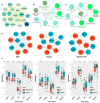Exploration of the Shared Molecular Mechanisms between COVID-19 and Neurodegenerative Diseases through Bioinformatic Analysis
- PMID: 36902271
- PMCID: PMC10002862
- DOI: 10.3390/ijms24054839
Exploration of the Shared Molecular Mechanisms between COVID-19 and Neurodegenerative Diseases through Bioinformatic Analysis
Abstract
The COVID-19 pandemic has caused millions of deaths and remains a major public health burden worldwide. Previous studies found that a large number of COVID-19 patients and survivors developed neurological symptoms and might be at high risk of neurodegenerative diseases, such as Alzheimer's disease (AD) and Parkinson's disease (PD). We aimed to explore the shared pathways between COVID-19, AD, and PD by using bioinformatic analysis to reveal potential mechanisms, which may explain the neurological symptoms and degeneration of brain that occur in COVID-19 patients, and to provide early intervention. In this study, gene expression datasets of the frontal cortex were employed to detect common differentially expressed genes (DEGs) of COVID-19, AD, and PD. A total of 52 common DEGs were then examined using functional annotation, protein-protein interaction (PPI) construction, candidate drug identification, and regulatory network analysis. We found that the involvement of the synaptic vesicle cycle and down-regulation of synapses were shared by these three diseases, suggesting that synaptic dysfunction might contribute to the onset and progress of neurodegenerative diseases caused by COVID-19. Five hub genes and one key module were obtained from the PPI network. Moreover, 5 drugs and 42 transcription factors (TFs) were also identified on the datasets. In conclusion, the results of our study provide new insights and directions for follow-up studies of the relationship between COVID-19 and neurodegenerative diseases. The hub genes and potential drugs we identified may provide promising treatment strategies to prevent COVID-19 patients from developing these disorders.
Keywords: Alzheimer’s disease; COVID-19; Parkinson’s disease; bioinformatics; differentially expressed genes; drugs; gene ontology; hub genes; protein–protein interaction.
Conflict of interest statement
The authors have no conflict of interest to report.
Figures








Similar articles
-
Analysis and Identification Genetic Effect of SARS-CoV-2 Infections to Alzheimer's Disease Patients by Integrated Bioinformatics.J Alzheimers Dis. 2022;85(2):729-744. doi: 10.3233/JAD-215086. J Alzheimers Dis. 2022. PMID: 34776447
-
Identification of miRNA-Target Gene Pairs in the Parietal and Frontal Lobes of the Brain in Patients with Alzheimer's Disease Using Bioinformatic Analyses.Neurochem Res. 2021 Apr;46(4):964-979. doi: 10.1007/s11064-020-03215-8. Epub 2021 Feb 13. Neurochem Res. 2021. PMID: 33586092
-
Integrating single-nucleus sequence profiling to reveal the transcriptional dynamics of Alzheimer's disease, Parkinson's disease, and multiple sclerosis.J Transl Med. 2023 Sep 21;21(1):649. doi: 10.1186/s12967-023-04516-6. J Transl Med. 2023. PMID: 37735671 Free PMC article.
-
Bioinformatics and systems biology approaches to identify the effects of COVID-19 on neurodegenerative diseases: A review.Medicine (Baltimore). 2022 Dec 9;101(49):e32100. doi: 10.1097/MD.0000000000032100. Medicine (Baltimore). 2022. PMID: 36626425 Free PMC article. Review.
-
Links between COVID-19 and Parkinson's disease/Alzheimer's disease: reciprocal impacts, medical care strategies and underlying mechanisms.Transl Neurodegener. 2023 Jan 30;12(1):5. doi: 10.1186/s40035-023-00337-1. Transl Neurodegener. 2023. PMID: 36717892 Free PMC article. Review.
Cited by
-
Cerebral blood flow alterations and host genetic association in individuals with long COVID: A transcriptomic-neuroimaging study.J Cereb Blood Flow Metab. 2025 Mar;45(3):431-442. doi: 10.1177/0271678X241277621. Epub 2024 Aug 23. J Cereb Blood Flow Metab. 2025. PMID: 39177056 Free PMC article.
-
Drug Repurposing for COVID-19 by Constructing a Comorbidity Network with Central Nervous System Disorders.Int J Mol Sci. 2024 Aug 16;25(16):8917. doi: 10.3390/ijms25168917. Int J Mol Sci. 2024. PMID: 39201608 Free PMC article.
-
FN1, a reliable prognostic biomarker for thyroid cancer, is associated with tumor immunity and an unfavorable prognosis.Oncol Lett. 2024 Aug 26;28(5):510. doi: 10.3892/ol.2024.14643. eCollection 2024 Nov. Oncol Lett. 2024. PMID: 39268167 Free PMC article.
-
A review and analysis of key biomarkers in Alzheimer's disease.Front Neurosci. 2024 Feb 20;18:1358998. doi: 10.3389/fnins.2024.1358998. eCollection 2024. Front Neurosci. 2024. PMID: 38445255 Free PMC article. Review.
-
Special Issue 'Advances in Neurodegenerative Diseases Research and Therapy 2.0'.Int J Mol Sci. 2024 Apr 26;25(9):4709. doi: 10.3390/ijms25094709. Int J Mol Sci. 2024. PMID: 38731928 Free PMC article.
References
-
- Ceban F., Ling S., Lui L.M.W., Lee Y., Gill H., Teopiz K.M., Rodrigues N.B., Subramaniapillai M., Di Vincenzo J.D., Cao B., et al. Fatigue and cognitive impairment in Post-COVID-19 Syndrome: A systematic review and meta-analysis. Brain Behav. Immun. 2022;101:93–135. doi: 10.1016/j.bbi.2021.12.020. - DOI - PMC - PubMed
-
- Taquet M., Sillett R., Zhu L., Mendel J., Camplisson I., Dercon Q., Harrison P.J. Neurological and psychiatric risk trajectories after SARS-CoV-2 infection: An analysis of 2-year retrospective cohort studies including 1 284 437 patients. Lancet Psychiatry. 2022;9:815–827. doi: 10.1016/S2215-0366(22)00260-7. - DOI - PMC - PubMed
MeSH terms
Grants and funding
LinkOut - more resources
Full Text Sources
Medical

